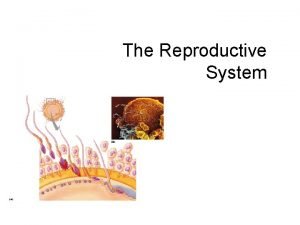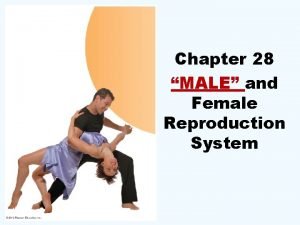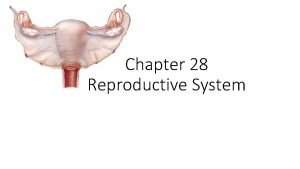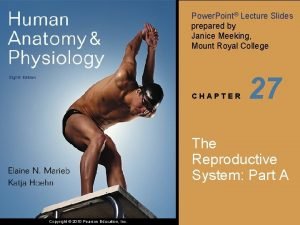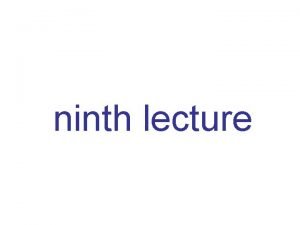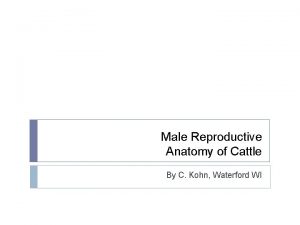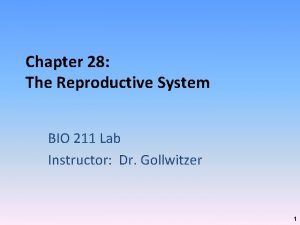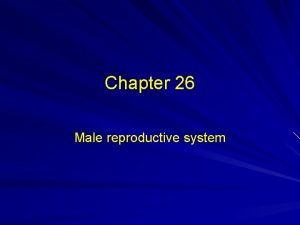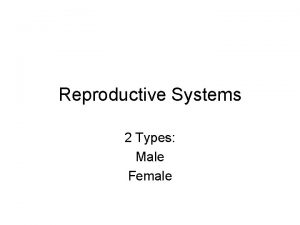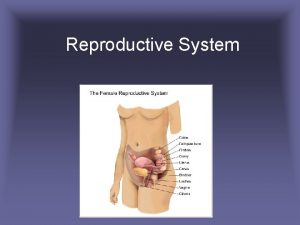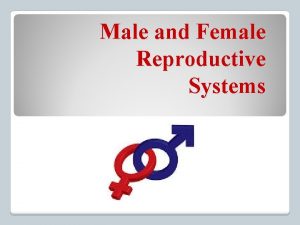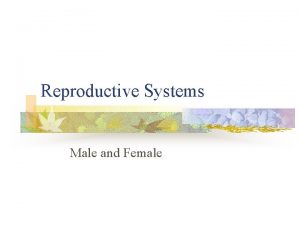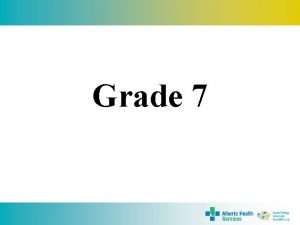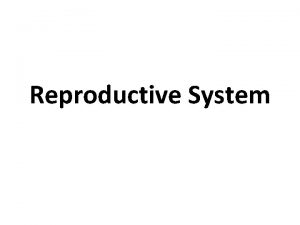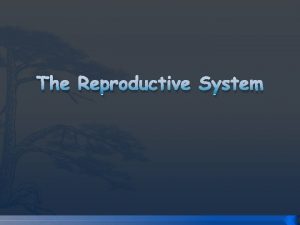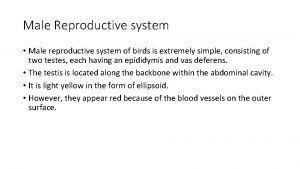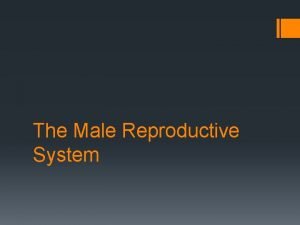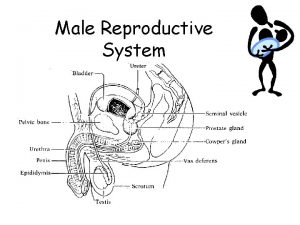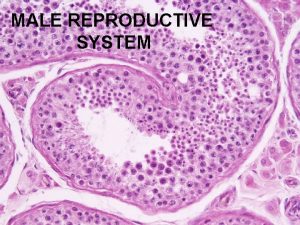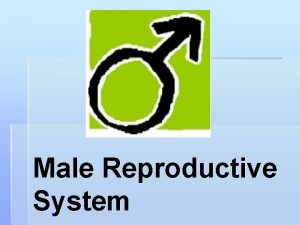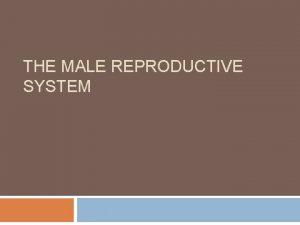Reproductive System Male Female Systems Ha Ha The




























- Slides: 28

Reproductive System Male & Female Systems

Ha Ha…

The Reproductive System The reproductive organs have 2 functions ◦ To create human offspring by combining genes from the male and female (male and female) ◦ To develop and nurture the fetus (female) During reproduction, the male and the female provide different components ◦ The male provides the sperm cell that fertilizes the female’s egg ◦ The female provides the egg for fertilization

Similarities There is a common general structure and function between both sexes Both sexes possess the following reproductive characteristics: ◦ ◦ ◦ Sex cell producing organs Sex cells Hormone-producing cells Duct systems External genitalia

Analogous Features in Both Sexes FEATURES FEMALE Essential Organs Ovaries Testes Sex Cells Ova (eggs) Sperm Hormones Estrogen & progesterone Testosterone Hormone-producing Cells Granulosa cells & corpus luteum Interstitial cells Duct Systems Fallopian tubes, uterus, & vagina Epididymis, urethra, and vas deferens External Genitals Clitoris & vulva Penis & scrotum

Male Reproductive System Essential organs (aka. Gonads) ◦ Testes (2) Accessory organs ◦ ◦ ◦ ◦ Epididymis (2) Vas deferens (2) Ejaculatory duct (2) Seminal vesicles (2) Prostate gland Cowper’s gland Urethra External genitalia Scrotum Penis

Male - Testes Male gonads The main sex glands ◦ Produce male sex cells (spermatozoa) within its structure ◦ Secrete the hormone testosterone Location - suspended outside the body ◦ This provides an environment about 3°F less than body temperature, which is a requirement for the production and survival of sperm (95. 6°F as opposed to 98. 6°F)

Male – Epididymis (2) A single, tightly coiled tube about 20 feet in length ◦ One on each side Location – ◦ Along the top and behind the testes inside the scrotum Purpose – ◦ Sperm mature and develop their ability to move or swim as they pass through the epididymis from the testes

Male – Vas Deferens (2) A muscular tube on each side of the scrotum Location – ◦ Extends into the abdominal cavity over the top and down the posterior surface of the bladder Purpose – ◦ Permits sperm to exit from the epididymis and pass from the scrotum into the abdominal cavity

Male – Ejaculatory Duct (2) Duct created by the joining of the vas deferens and the seminal vesicle Location – ◦ Posterior surface of the bladder, passing through the prostate gland, and joining with the urethra Purpose – ◦ To allow mixing of the components of the semen and delivery of the semen to the urethra

Male – Seminal Vesicles (2) Pouch-like glands Location – ◦ Above the prostate gland behind the bladder Purpose – ◦ Produces about 60% of the volume of the seminal fluid ◦ This component of seminal fluid is high in fructose, which the sperm use as a source of energy for movement

Male – Prostate Gland Donut-shaped, hormone secreting gland Location – ◦ Sits just below the bladder ◦ The urethra passes through its center Purpose – ◦ Secretes about 30% of the seminal fluid ◦ Helps to activate and maintain the motility of sperm

Male – Cowper’s Glands (2) Have the shape and size of a pea Location – ◦ Just below the prostate gland ◦ Empties into the urethra Purpose – ◦ Produces <5% of the seminal fluid ◦ Responsible for lubrication of the urethra

Male - Urethra Tube leading to the outside of the body from the urogenital area Location – ◦ Begins at the bladder and extends through the prostate gland, past the seminal vesicles and Cowper’s glands, through the penis, and opens to the exterior at the external urethral orifice Purpose – ◦ To allow the passage of urine and seminal fluid to the outside of the body

Male - Scrotum External reproductive organ Skin-covered pouch suspended from the groin Divided internally into 2 sacs Each sac contains a teste, epididymis, and a portion of the vas deferens

Male - Penis External reproductive organ Responsible for delivery of semen into the vagina for fertilization of the female’s egg Parts ◦ Glans penis – enlarged distal end ◦ Prepuce – aka foreskin; covers the glans penis ◦ Shaft Urethra Erectile tissue Corpora cavernosa – 2; run parallel to each other along the length of the shaft Corpus spongiosum – 1; under the corpora cavernosa During arousal the spongy tissue fills with blood, causing rigidity This rigidity enables better placement of the semen for better chances of fertilization

Male - Semen A mixture of sperm produced by the testes and secretions of the supportive sex glands ◦ 95% of the semen is contributed by the supportive sex glands ◦ The sperm and fluid from the testes contribute <5% of the seminal fluid volume Roughly 3 -5 ml (1 tsp) of semen is ejaculated at one time ◦ Each milliliter normally contains about 100 million sperm ◦ Semen is alkaline in order to protect the sperm from the acidic environment of the female reproductive tract

Female Reproductive System Essential organs (aka. Gonads) ◦ Ovaries (2) Accessory organs ◦ ◦ ◦ Uterine (fallopian) tubes (2) Uterus Bartholin’s glands (2) Breasts (2) Vagina Vulva

Female – Ovaries (2) Female gonads The main sex gland ◦ Produce female sex cells (ova) within its structure Babies are born with the potential to develop ~1 million mature eggs By puberty, that number has been reduced to ~400, 000 Throughout the reproductive lifespan, a woman only actually develops about 350 -500 eggs for fertilization Location – Attached to ligaments within the pelvic cavity on either side of the uterus

Female – Fallopian Tubes (2) Tubes that end in a funnel-like structure ◦ These funnel-like structures curve over the tops of the ovaries and open into the abdominal cavity Location – ◦ Attached to the uterus on one end and extended around the ovaries on the opposite end Purpose – ◦ Serve as the ducts for the ovaries ◦ Facilitate passage of the eggs released from the ovaries into the uterus ◦ The upper 1/3 of the tube is the usual site for fertilization when it occurs

Female - Uterus Strong, pear-sized organ ◦ Made of muscle tissue with a small cavity inside Has 2 parts ◦ The body (upper portion) The bulging top area above where the fallopian tubes attach is called the fundus ◦ The cervix (lower portion) Location – ◦ Non-pregnancy: behind the bladder in the pelvic cavity ◦ Pregnancy: Extends from the pelvic cavity up to the top of the abdominal cavity (pushes the liver against the diaphragm)

Female – Uterus Has a purpose in 3 functions ◦ Menstruation – monthly process In preparation for pregnancy, the inner walls of the uterus become lined with a well-vascularized mucous membrane (endometrium) When no pregnancy occurs, the lining tears away from the walls, causing bleeding, and is shed as menstrual blood ◦ Pregnancy The fertilized egg implants in the endometrium The implantation site become the attachment site for the placenta Fetal development takes place within the uterus ◦ Labor The muscular nature of the uterus serves its purpose to help push the baby from the uterus, through the cervix and vagina, and out of the body

Female – Bartholin’s Glands (2) Location – ◦ Located on each side of the vaginal opening Purpose – ◦ Secretion of a lubricating fluid to facilitate fertilization and shedding of menstrual components

Female - Breasts Combination of glandular and fatty tissue ◦ Include the lactiferous ducts, areola, and nipples Location – ◦ Positioned over the pectoral muscles ◦ Attached by the ligaments of Cooper Purpose – ◦ Milk production and secretion for the feeding of infants

Female - Vagina An approximately 4 -inch long distensible tube, made mostly of smooth muscle Location – ◦ Lies in the pelvic cavity between the urinary bladder and the rectum Purpose – ◦ To direct sperm into the uterus and fallopian tubes ◦ To allow passage of an infant from the mother’s body

Female - Vulva The external genitalia Consists of the following: ◦ Mons pubis – Skin-covered pad of fat over the pubic symphysis Protective ◦ Clitoris Nerve bundle below mons pubis ◦ Orifice of the urethra External opening of urinary system ◦ Labia minora & labia majora Modified skin on the external genitalia that serve a protective purpose ◦ Orifice of vagina External opening of the reproductive system

Fetal Development An egg is released from the ovary and travels into the fallopian tube Intercourse occurs The sperm travel from the vagina, through the cervix, up into the uterus, and into the fallopian tubes (long journey – you can see why there are so many ejaculated) If fertilization occurs, a protective membrane will develop around the egg to keep further intruders out

Fetal Development The fertilized egg, now called a zygote, travels down into the uterus within 3 -5 days The zygote implants in the endometrial wall on the uterus and begins to divide and multiply its cells to form the fetus and the placenta ◦ Protective membrane containing fluid and nutrients During the approximately 9 months of gestation the fetus is enclosed in the placenta ◦ It is nourished by and receives oxygen from the mother’s blood through the placenta via the umbilical cord Wastes return through the placenta to the mother and are eliminated through her respiratory and excretory systems
 Male and female reproductive system
Male and female reproductive system Female and male reproductive system
Female and male reproductive system Differences between male and female reproductive organ
Differences between male and female reproductive organ Drawing of the male and female reproductive system
Drawing of the male and female reproductive system Penis circumcised
Penis circumcised Cartilaginous fish vs bony fish
Cartilaginous fish vs bony fish Vesicular (graafian) follicle
Vesicular (graafian) follicle Male reproductive system from front
Male reproductive system from front Male genital hygiene
Male genital hygiene Exercise 42 review male reproductive system
Exercise 42 review male reproductive system Oogenesis diagram
Oogenesis diagram Broad ligament
Broad ligament Male reproductive system
Male reproductive system Luteinizing hormone in male reproductive system
Luteinizing hormone in male reproductive system Reproduction in human
Reproduction in human Art-labeling activity: the male reproductive system, part 1
Art-labeling activity: the male reproductive system, part 1 Male reproductive system information
Male reproductive system information Where is the sperm located
Where is the sperm located Male reproductive system
Male reproductive system Prostate glan
Prostate glan Male reproductive system plants
Male reproductive system plants Function of male reproductive system
Function of male reproductive system Reporoductive system
Reporoductive system Fetal pig masseter muscle
Fetal pig masseter muscle Female part of a flower
Female part of a flower Figure 28-1 the male reproductive system
Figure 28-1 the male reproductive system Base of prostate gland
Base of prostate gland Chapter 20 reproduction and pregnancy
Chapter 20 reproduction and pregnancy Cows reproductive system
Cows reproductive system


